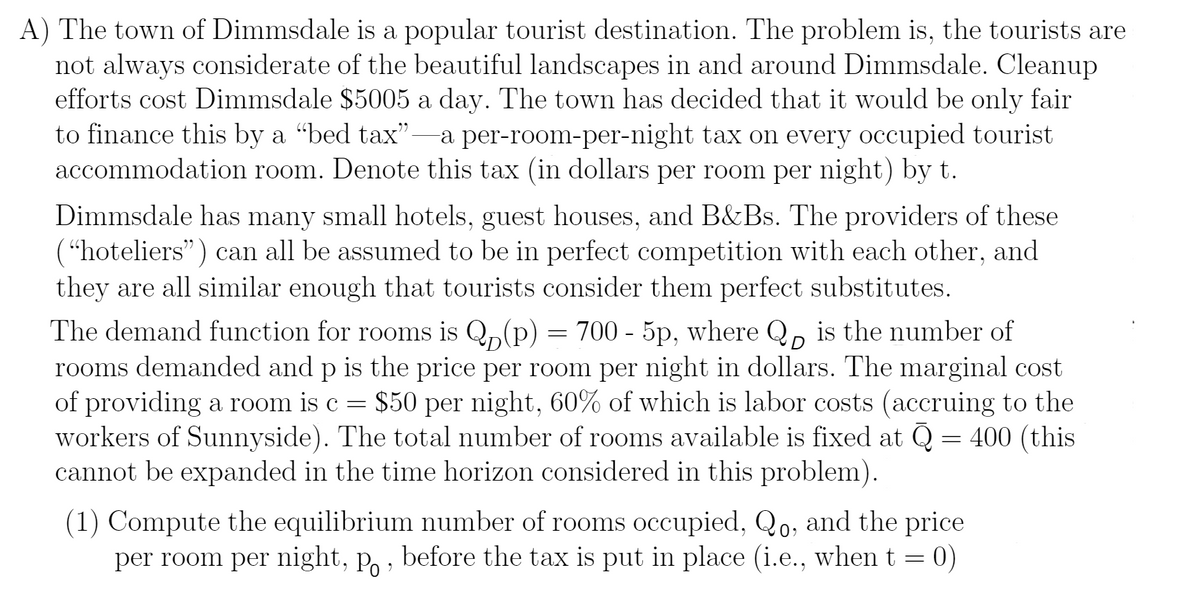The demand function for rooms is Q,(p) = 700 - 5p, where Q, is the number of rooms demanded and p is the price per room per night in dollars. The marginal cost of providing a room is c = workers of Sunnyside). The total number of rooms available is fixed at Q = 400 (this cannot be expanded in the time horizon considered in this problem). $50 per night, 60% of which is labor costs (accruing to the (1) Compute the equilibrium number of rooms occupied, Qo, and the price per room per night, p, , before the tax is put in place (i.e., when t = 0)
The demand function for rooms is Q,(p) = 700 - 5p, where Q, is the number of rooms demanded and p is the price per room per night in dollars. The marginal cost of providing a room is c = workers of Sunnyside). The total number of rooms available is fixed at Q = 400 (this cannot be expanded in the time horizon considered in this problem). $50 per night, 60% of which is labor costs (accruing to the (1) Compute the equilibrium number of rooms occupied, Qo, and the price per room per night, p, , before the tax is put in place (i.e., when t = 0)
Managerial Economics: Applications, Strategies and Tactics (MindTap Course List)
14th Edition
ISBN:9781305506381
Author:James R. McGuigan, R. Charles Moyer, Frederick H.deB. Harris
Publisher:James R. McGuigan, R. Charles Moyer, Frederick H.deB. Harris
Chapter3: Demand Analysis
Section: Chapter Questions
Problem 11E: Federal excise taxes on gasoline vary widely across the developed world. The United States has the...
Related questions
Question

Transcribed Image Text:A) The town of Dimmsdale is a popular tourist destination. The problem is, the tourists are
not always considerate of the beautiful landscapes in and around Dimmsdale. Cleanup
efforts cost Dimmsdale $5005 a day. The town has decided that it would be only fair
to finance this by a "bed tax"-a per-room-per-night tax on every occupied tourist
accommodation room. Denote this tax (in dollars per room per night) by t.
Dimmsdale has many small hotels, guest houses, and B&Bs. The providers of these
(“hoteliers") can all be assumed to be in perfect competition with each other, and
they are all similar enough that tourists consider them perfect substitutes.
The demand function for rooms is Q,(p)
700 - 5p, where Q, is the number of
rooms demanded and p is the price per room per night in dollars. The marginal cost
of providing a room is c = $50 per night, 60% of which is labor costs (accruing to the
workers of Sunnyside). The total number of rooms available is fixed at Q = 400 (this
cannot be expanded in the time horizon considered in this problem).
(1) Compute the equilibrium number of rooms occupied, Qo, and the price
per room per night, p; before the tax is put in place (i.e., when t = 0)
Expert Solution
This question has been solved!
Explore an expertly crafted, step-by-step solution for a thorough understanding of key concepts.
Step by step
Solved in 2 steps

Knowledge Booster
Learn more about
Need a deep-dive on the concept behind this application? Look no further. Learn more about this topic, economics and related others by exploring similar questions and additional content below.Recommended textbooks for you

Managerial Economics: Applications, Strategies an…
Economics
ISBN:
9781305506381
Author:
James R. McGuigan, R. Charles Moyer, Frederick H.deB. Harris
Publisher:
Cengage Learning

Managerial Economics: Applications, Strategies an…
Economics
ISBN:
9781305506381
Author:
James R. McGuigan, R. Charles Moyer, Frederick H.deB. Harris
Publisher:
Cengage Learning